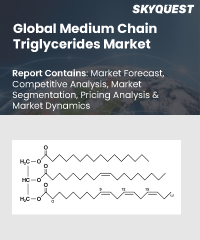
Report ID: SQMIG15E2237

Report ID:
SQMIG15E2237 |
Region:
Global |
Published Date: March, 2024
Pages:
184
|
Tables:
90 |
Figures:
76
Medium Chain Triglycerides Market size was valued at USD 2.21 Billion in 2023 and is poised to grow from USD 2.36 Billion in 2024 to USD 3.99 Billion by 2032, growing at a CAGR of 6.8% during the forecast period (2025-2032).
A rise in living and customer acceptance of a healthy lifestyle are expected to be the primary drivers of the consumption of dietary and medical supplements based on medium-chain triglyceride (MCT) over the projected period.
MCTs are partially generated lipids with chains that are between 6 and 10 carbons long. MCTs include caproic acids, caprylic acid, capric acids, and lauric acid. Typically, vegetable oils like soybean, rapeseed, coconuts, palm kernel, & sunflower are used to make the product. According to reports, coconut oil is the primary source of MCT extraction. Palm kernel oil is the second most favored raw material after coconut oil in the production of MCTs, making up around 34.0% of the total.
Several small-scale market participants advertise items infused with coconut oil as MCT-infused products. It is believed that this could hinder market growth because medium-chain triglyceride and coconut oil are confusing to customers. The main distinction among the two is that while particular MCTs are derived from other fats, coconut oil also contains MCTs.
Capric and caprylic acid are separated from the other fats in the vegetable oils during the fractionation process, which is the method used to make MCTs for commercial use. Through lipase esterification, triglycerides are produced from the extracted product. The final item is provided as a finished good for consumption following a number of quality checks.
Additionally, the extracted product has a 5:2 ratio for each and a higher content of caprylic acid and capric acid compared to other glycerides. However, caproic acid is typically taken out of the residual product due to its disagreeable taste and odor. Additionally, the benefits of lauric acid (C12), which is typically absent from products marketed on the market, are controversial.
Our industry expert will work with you to provide you with customized data in a short amount of time.
REQUEST FREE CUSTOMIZATIONWant to customize this report? This report can be personalized according to your needs. Our analysts and industry experts will work directly with you to understand your requirements and provide you with customized data in a short amount of time. We offer $1000 worth of FREE customization at the time of purchase.

Report ID: SQMIG15E2237